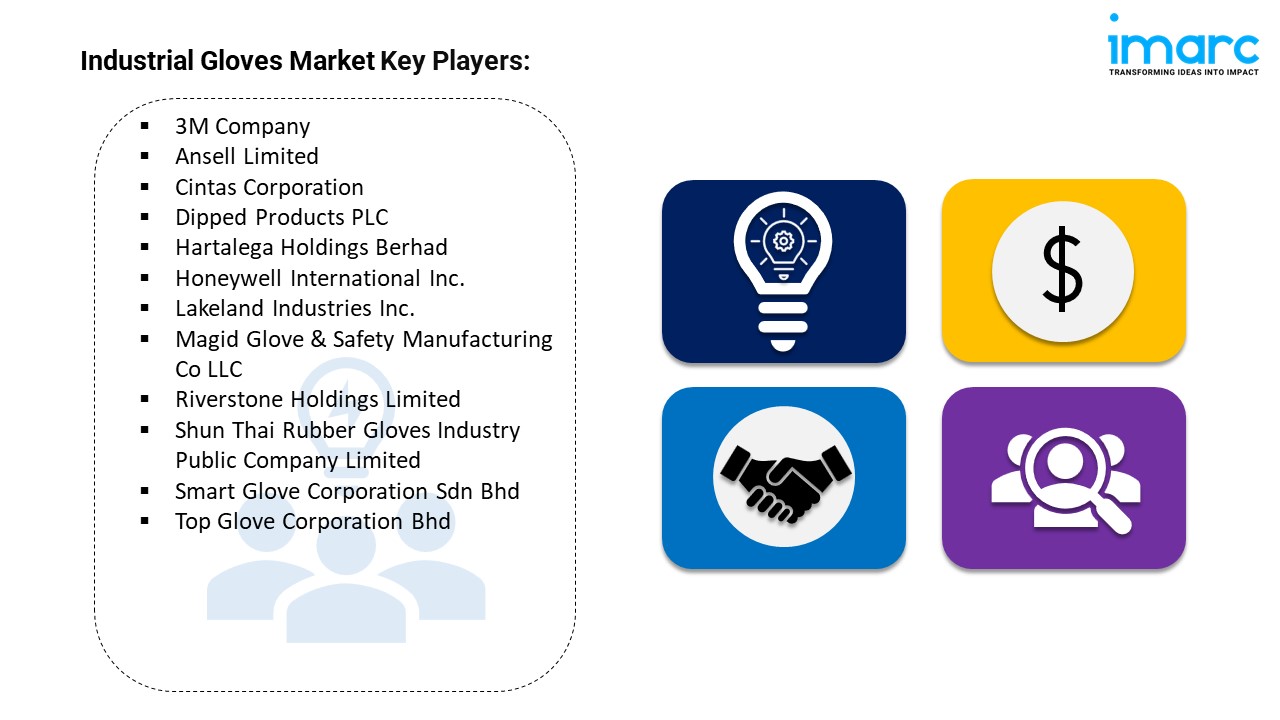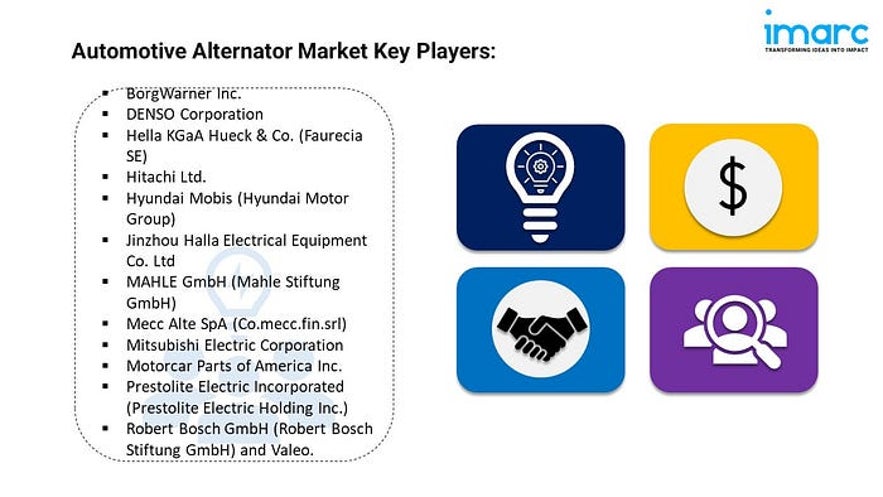stanley_imarc's blog
Global Virtual Reality Content Creation Market Statistics: USD 162.5 Billion Value by 2032
Summary:
- The global virtual reality content creation market size reached USD 5.1 Billion in 2023.
- The market is expected to reach USD 162.5 Billion by 2032, exhibiting a growth rate (CAGR) of 45.39% during 2024–2032.
- Asia Pacific leads the market, accounting for the largest virtual reality content creation market share.
- Videos account for the majority of the market share in the content type segment as they offer users a wide range of engaging content.
- Software holds the largest share in the virtual reality content creation industry.
- Gaming remains a dominant segment in the market due to the rising focus on immersive and interactive playing experiences.
- The rising popularity of gaming and entertainment is a primary driver of the virtual reality content creation market.
- The increasing demand for immersive experiences and technological advancements in VR technology are reshaping the virtual reality content creation market.
Industry Trends and Drivers:
● Growing Demand for Immersive Experiences:
The rising demand for immersive experiences among individuals is supporting the market growth. People are increasingly seeking interactive and engaging environments that offer more than traditional media. Virtual reality (VR) provides a unique opportunity to immerse users in fully simulated worlds, enhancing their experiences in gaming, entertainment, and education. This heightened engagement is leading to higher user satisfaction and more time spent within virtual environments. As consumers become more accustomed to these immersive experiences, the demand for diverse and high-quality VR content grows. The appeal of experiencing stories, learning new skills, or exploring new environments in a highly interactive manner is contributing to the market growth.
● Rising Popularity of Gaming and Entertainment:
The increasing popularity of gaming and entertainment is impelling the market growth. VR offers a novel way to experience games and media, providing deeper immersion and interactivity as compared to traditional formats. In addition, developers in the industry are creating games specifically designed for VR platforms to attract a broader consumer base. This trend extends to entertainment, where VR films, concerts, and other interactive experiences are gaining traction. As more content is developed for these platforms and consumer interest continues to rise, the demand for innovative VR content grows. The success of VR in these sectors highlights its potential and encourages further investment and creativity in content development.
● Technological Advancements in VR Technology:
Improvements in hardware, such as more sophisticated headsets, haptic feedback devices, and motion sensors, enhance the realism and quality of VR experiences. These technological innovations make VR content more engaging and accessible, attracting a broader audience. High-resolution displays, improved tracking systems, and more responsive controllers enable developers to create richer and more immersive content. Besides this, advancements in spatial audio technology enable VR experiences to include high-fidelity and three dimensional (3D) soundscapes that match the virtual environment’s spatial layout. This audio realism enhances immersion by providing cues that align with visual and interactive elements, making virtual experiences more convincing and engaging.
Request for a sample copy of this report: https://www.imarcgroup.com/virtual-reality-content-creation-market/requestsample
Virtual Reality Content Creation Market Report Segmentation:
Breakup By Content Type:
- Videos
- 360 Degree Photos
- Games
Videos account for the majority of shares as they offer users a wide range of engaging content.
Breakup By Component:
- Software
- Services
Software dominates the market on account of its pivotal role in designing, developing, and optimizing VR experiences.
Breakup By End User:

- Real Estate
- Travel and Hospitality
- Media and Entertainment
- Healthcare
- Retail
- Gaming
- Automotive
- Others
Gaming represents the majority of shares due to the rising focus on immersive and interactive playing experiences.
Breakup By Region:
- North America (United States, Canada)
- Asia Pacific (China, Japan, India, South Korea, Australia, Indonesia, Others)
- Europe (Germany, France, United Kingdom, Italy, Spain, Russia, Others)
- Latin America (Brazil, Mexico, Others)
- Middle East and Africa
Asia Pacific enjoys the leading position owing to a large market for virtual reality content creation driven by favorable government initiatives.
Top Virtual Reality Content Creation Market Leaders:
The virtual reality content creation market research report outlines a detailed analysis of the competitive landscape, offering in-depth profiles of major companies. Some of the key players in the market are:

- 360 Labs
- Blippar Group Limited
- Dell Inc
- Koncept VR LLC
- Matterport Inc.
- Panedia Pty Ltd.
- Scapic Innovations Private Limited
- Subvrsive
- VIAR Inc
- WeMakeVR
If you require any specific information that is not covered currently within the scope of the report, we will provide the same as a part of the customization.
About Us:
IMARC Group is a global management consulting firm that helps the world’s most ambitious changemakers to create a lasting impact. The company provide a comprehensive suite of market entry and expansion services. IMARC offerings include thorough market assessment, feasibility studies, company incorporation assistance, factory setup support, regulatory approvals and licensing navigation, branding, marketing and sales strategies, competitive landscape and benchmarking analyses, pricing and cost research, and procurement research.
Contact Us:
IMARC Group
134 N 4th St. Brooklyn, NY 11249, USA
Email: [email protected]
Tel No:(D) +91 120 433 0800
United States: +1–631–791–1145
Global Air Defense Systems Market Statistics: USD 70.5 Billion Value by 2032
Summary:
- The global air defense systems market size reached USD 47.2 Billion in 2023.
- The market is expected to reach USD 70.5 Billion by 2032, exhibiting a growth rate (CAGR) of 4.43% during 2024-2032.
- Asia Pacific leads the market, accounting for the largest air defense systems market share.
- Missile defense systems account for the majority of the market share due to their utilization in countering high-speed ballistic and cruise missiles.
- Long-range air defense system (LRAD) holds the biggest market share owing to its critical strategic defense against high-altitude, long-distance threats, essential for safeguarding large territories and important assets.
- Innovations in radar technology and sensors are improving the detection range and accuracy of air defense systems.
- Rising tensions among nations can lead to an arms race where countries seek to bolster their defense capabilities against potential aerial attacks.
Request for a sample copy of this report: https://www.imarcgroup.com/air-defense-systems-market/requestsample
Industry Trends and Drivers:
- Technological Advancements:
Innovations in radar technology and sensors are improving the detection range and accuracy of air defense systems. Modern radar systems can detect and track smaller, faster, and more maneuverable targets, such as stealth aircraft and drones. This improvement in early detection capabilities allows for more effective defensive actions. The development of new interception technologies, including directed energy weapons (lasers) and electromagnetic railguns, provides new ways to neutralize threats. These technologies offer precision and a potentially lower cost per shot compared to traditional missile systems.
- Increasing Security Threats:
Rising tensions among nations can lead to an arms race where countries seek to bolster their defense capabilities against potential aerial attacks. This includes the deployment of advanced air defense systems capable of protecting national airspace against intrusions and attacks. As offensive technologies, including hypersonic missiles and stealth aircraft, are becoming more accessible, the need for equally sophisticated air defense systems is increasing. These systems must evolve to counter the capabilities of new offensive weapons that can bypass traditional defenses.
- Modernization Programs:
Many of the existing air defense systems in various countries are based on older technology that may not be effective against modern threats, such as advanced missiles, drones, and stealth aircraft. Modernization programs aim to replace these outdated systems with newer, more capable versions that can detect, track, and intercept advanced threats. Modernization efforts often include integrating cutting-edge technologies like artificial intelligence (AI), machine learning (ML), and network-centric systems into air defense platforms. These technologies improve the accuracy, speed, and efficiency of air defense operations, enhancing overall military effectiveness.
The air defense systems market forecast offers insights into future opportunities and challenges, drawing on historical data and predictive modeling.
Air Defense Systems Market Report Segmentation:
By Component:
- Weapon System
- Fire Control System
- Command and Control System
- Others
Weapon system represents the largest segment as it forms the core of air defense capabilities, encompassing various interceptors and missiles, which are essential for neutralizing incoming threats, thus driving their dominant market share.
By Type:
- Missile Defense Systems
- Anti-aircraft Systems
- Counter Unmanned Aerial Systems (C-UAS)
- Counter Rocket, Artillery and Mortar (C-RAM) Systems
Missile defense systems account for the majority of the market share due to their utilization in countering high-speed ballistic and cruise missiles.
By Platform:
- Airborne
- Land
- Naval
Land exhibits a clear dominance in the market. Land platforms are pivotal for national and border defense, offering a stable and widespread deployment option that integrates seamlessly with other military operations, making them the most common choice.
By Range:
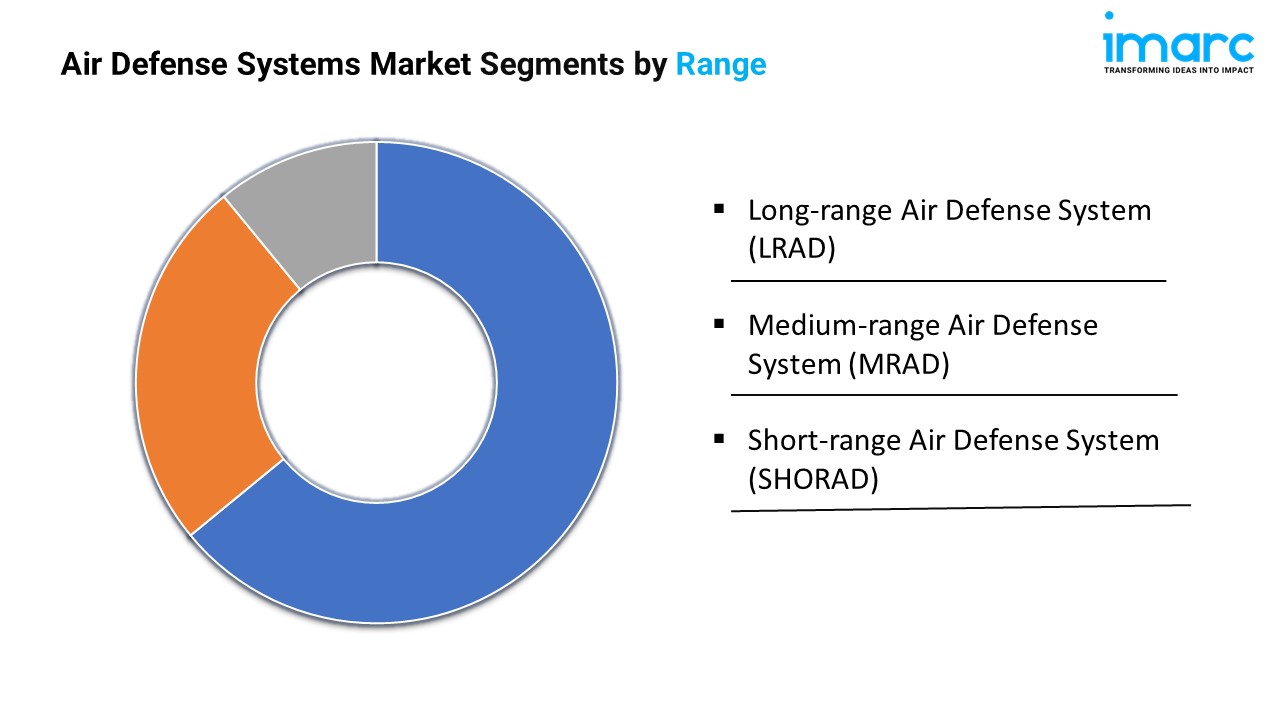
- Long-range Air Defense System (LRAD)
- Medium-range Air Defense System (MRAD)
- Short-range Air Defense System (SHORAD)
Long-range air defense system (LRAD) holds the biggest market share owing to its critical strategic defense against high-altitude, long-distance threats, essential for safeguarding large territories and important assets.
Regional Insights:
- North America (United States, Canada)
- Asia Pacific (China, Japan, India, South Korea, Australia, Indonesia, Others)
- Europe (Germany, France, United Kingdom, Italy, Spain, Russia, Others)
- Latin America (Brazil, Mexico, Others)
- Middle East and Africa
Asia Pacific enjoys the leading position in the air defense systems market. The Asia Pacific region faces numerous security challenges and territorial disputes, leading to significant investments in advanced air defense systems to ensure regional stability and security.
Top Air Defense Systems Market Leaders:
The air defense systems market research report outlines a detailed analysis of the competitive landscape, offering in-depth profiles of major companies. Some of the key players in the market are:
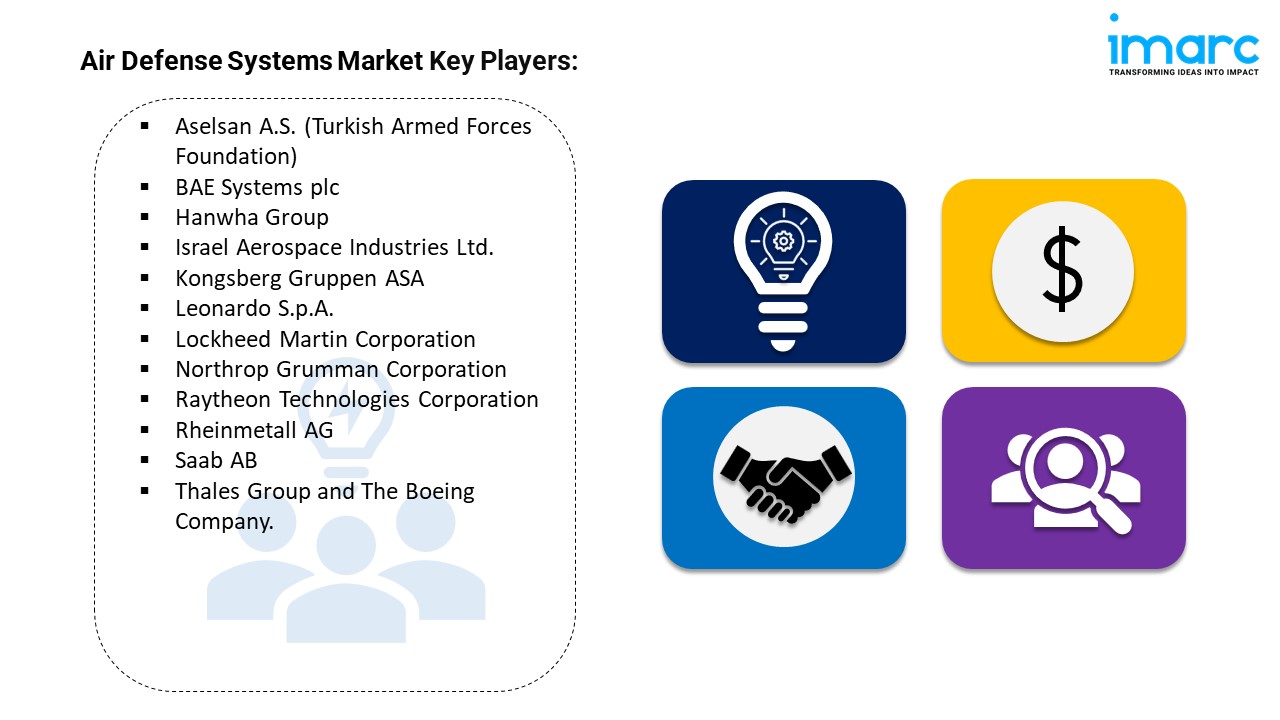
- Aselsan A.S. (Turkish Armed Forces Foundation)
- BAE Systems plc
- Hanwha Group
- Israel Aerospace Industries Ltd.
- Kongsberg Gruppen ASA
- Leonardo S.p.A.
- Lockheed Martin Corporation
- Northrop Grumman Corporation
- Raytheon Technologies Corporation
- Rheinmetall AG
- Saab AB
- Thales Group and The Boeing Company.
Note: If you require any specific information that is not covered currently within the scope of the report, we will provide the same as a part of the customization.
About Us:
IMARC Group is a global management consulting firm that helps the world’s most ambitious changemakers to create a lasting impact. The company provide a comprehensive suite of market entry and expansion services. IMARC offerings include thorough market assessment, feasibility studies, company incorporation assistance, factory setup support, regulatory approvals and licensing navigation, branding, marketing and sales strategies, competitive landscape and benchmarking analyses, pricing and cost research, and procurement research.
Contact Us:
IMARC Group
134 N 4th St. Brooklyn, NY 11249, USA
Email: [email protected]
Tel No:(D) +91 120 433 0800
United States: +1-631-791-1145
Global Camping Equipment Industry: Key Statistics and Insights in 2024-2032
Summary:
- The global camping equipment market size reached USD 16.7 Billion in 2023.
- The market is expected to reach USD 26.6 Billion by 2032, exhibiting a growth rate (CAGR) of 5.2% during 2024-2032.
- North America leads the market, accounting for the largest camping equipment market share.
- Backpacks account for the majority of the market share in the product type segment due to their ability to provide space for storing and carrying camping gear and personal items.
- Offline holds the largest share in the camping equipment industry.
- The rising interest in outdoor activities is a primary driver of the camping equipment market.
- The increasing need for eco-friendly and lightweight materials and the popularity of glamping are reshaping the camping equipment market.
Camping Equipment Industry Trends and Drivers:
- Rising Interest in Outdoor Activities:
The increasing interest in outdoor activities, particularly camping, as more individuals and families are seeking to connect with nature, is impelling the market growth. The rising awareness among individuals about the benefits of spending time outdoors, such as reduced stress and improved mental well-being, is bolstering the market growth. Camping is becoming a popular choice for vacations and leisure activities. Outdoor activities became safer alternatives to traditional travel and entertainment. This shift is leading to an increase in the demand for camping gear, ranging from tents and sleeping bags to portable cooking equipment. Furthermore, social media platforms are showcasing camping experiences that also add to the popularity of camping.
- Increasing Need for Eco-Friendly and Lightweight Materials:
Sustainability is increasingly influencing individual decisions, and the camping equipment market is no exception. Manufacturers are responding to this shift by designing products made from eco-friendly, durable, and lightweight materials. These materials appeal to eco-conscious consumers who prioritize reducing their ecological footprint while engaging in outdoor activities. Recyclable fabrics, biodegradable materials, and responsibly sourced components are now key features in many camping products. Additionally, lightweight materials enhance portability, a significant consideration for hikers and campers who travel long distances on foot. This shift toward eco-friendly innovation not only broadens the market by attracting new consumers but also drives repeat purchases from loyal users seeking high-quality and sustainable gear.
- Growing Popularity of Glamping:
The rising popularity of glamping among individuals worldwide is bolstering the market growth. Glamping offers a blend of outdoor experiences with luxury amenities, appealing to individuals who enjoy nature but prefer more comfort than traditional camping. This segment of the market demands high-end camping equipment, such as large, stylish tents, portable heating systems, and comfortable bedding. The rising number of glamping resorts and vacation services is catalyzing the demand for premium camping gear, as these businesses require durable and aesthetically pleasing products to enhance their offerings. The glamping trend particularly resonate with millennials and urban dwellers, who appreciate the combination of adventure and luxury.
Request for a sample copy of this report: https://www.imarcgroup.com/camping-equipment-market/requestsample
Camping Equipment Market Report Segmentation:
Breakup By Product Type:
- Backpacks
- Sleeping Bags
- Tents and Accessories
- Cooking Systems and Cookware
- Others
Backpacks account for the majority of shares due to their ability to provide space for storing and carrying camping gear and personal items.
Breakup By Distribution Channel:
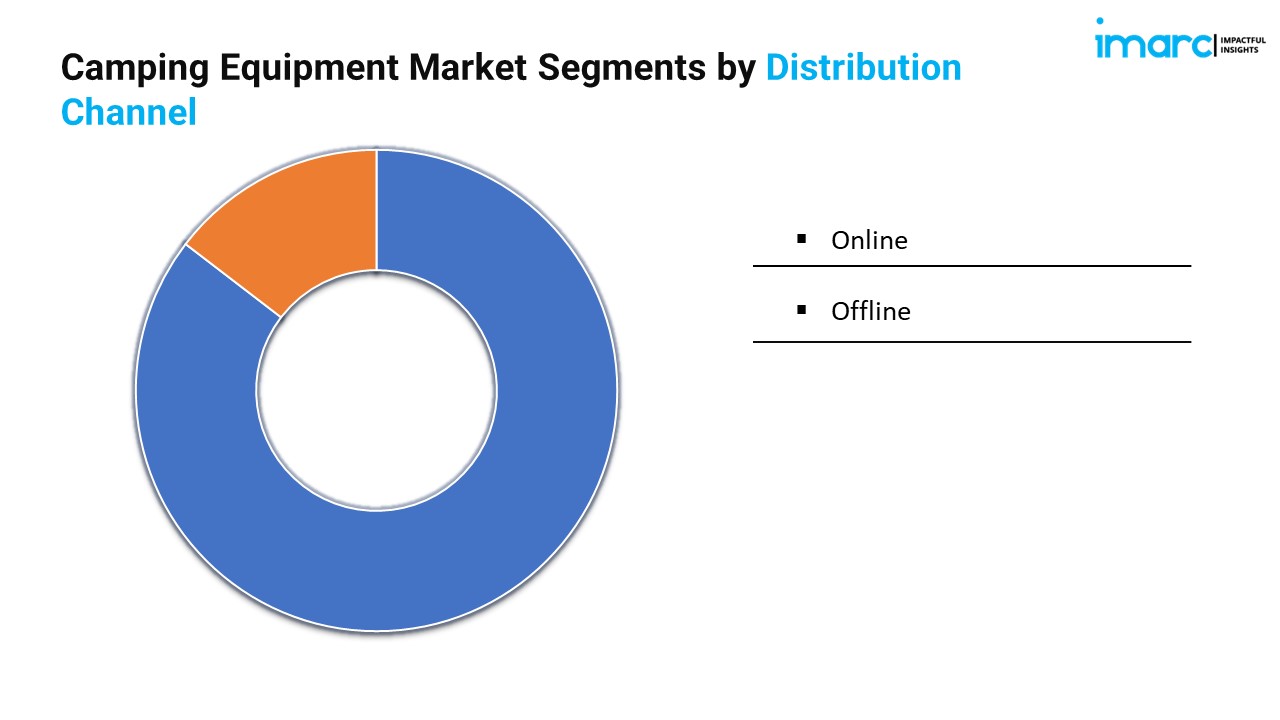
- Online
- Offline
Offline dominates the market as it allows individuals to physically visit to purchase camping equipment.
Breakup By Region:
- North America (United States, Canada)
- Asia Pacific (China, Japan, India, South Korea, Australia, Indonesia, Others)
- Europe (Germany, France, United Kingdom, Italy, Spain, Russia, Others)
- Latin America (Brazil, Mexico, Others)
- Middle East and Africa
North America enjoys the leading position sowing to a large market for camping equipment driven by the presence of vast and diverse natural landscape, including national parks, forests, mountains, and coastal areas.
Top Camping Equipment Market Leaders:
The camping equipment market research report outlines a detailed analysis of the competitive landscape, offering in-depth profiles of major companies. Some of the key players in the market are:
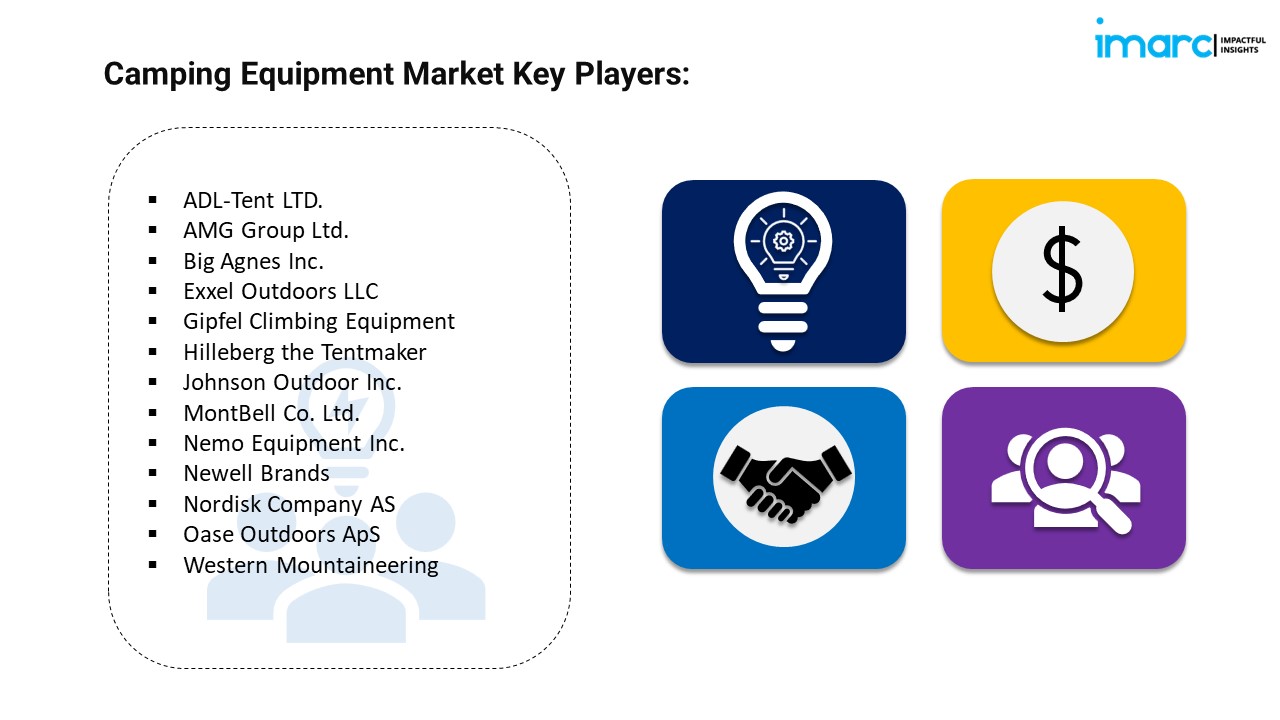
- ADL-Tent LTD.
- AMG Group Ltd.
- Big Agnes Inc.
- Exxel Outdoors LLC
- Gipfel Climbing Equipment
- Hilleberg the Tentmaker
- Johnson Outdoor Inc.
- MontBell Co. Ltd.
- Nemo Equipment Inc.
- Newell Brands
- Nordisk Company AS
- Oase Outdoors ApS
- Western Mountaineering
If you require any specific information that is not covered currently within the scope of the report, we will provide the same as a part of the customization.
About Us:
IMARC Group is a global management consulting firm that helps the world’s most ambitious changemakers to create a lasting impact. The company provide a comprehensive suite of market entry and expansion services. IMARC offerings include thorough market assessment, feasibility studies, company incorporation assistance, factory setup support, regulatory approvals and licensing navigation, branding, marketing and sales strategies, competitive landscape and benchmarking analyses, pricing and cost research, and procurement research.
Contact Us:
IMARC Group
134 N 4th St. Brooklyn, NY 11249, USA
Email: [email protected]
Tel No:(D) +91 120 433 0800
United States: +1-631-791-1145
Global Small Drones Industry: Key Statistics and Insights in 2024-2032
Summary:
- The global small drones market size reached USD 11.5 Billion in 2023
- The market is expected to reach USD 35.8 Billion by 2032, exhibiting a growth rate (CAGR) of 13.1% during 2024-2032.
- North America leads the market, accounting for the largest small drones market share.
- Micro drones account for the majority of the market share in the size segment due to their ability to perform detailed inspections and gather data in tight spaces.
- Rotary wing holds the largest share in the small drone industry.
- Military and defense remain a dominant segment in the market owing to the critical role of small drones in providing real-time intelligence, enhancing situational awareness, and executing precision operations.
- The increasing adoption of small drones in various industries is a primary driver of the small drones market.
- Ongoing technological improvements, along with the growing use of small drones in military and defense operations, are reshaping the small drones market.
Industry Trends and Drivers:
- Increasing adoption in commercial applications:
Businesses are adopting small drones for various commercial applications, including aerial photography, surveillance, and agricultural monitoring. Companies are leveraging these drones to improve operational efficiency, reduce costs, and enhance data collection capabilities. The demand for small drones is increasing in sectors like real estate, construction, and agriculture, where they provide a cost-effective solution for tasks that traditionally require manned aircraft or extensive labor. This expanding use of drones in commercial operations is propelling the market growth, as companies are finding innovative ways to integrate drones into their day-to-day activities, boosting efficiency and productivity. Furthermore, regulatory frameworks are evolving to accommodate drone usage, making it easier for businesses to adopt this technology across various industries.
- Advances in drone technology:
Ongoing advancements in drone technology are improving the performance and capabilities of small drones. Manufacturers are enhancing flight time, battery efficiency, and camera quality, while also integrating advanced features like obstacle detection, autonomous flight, and artificial intelligence (AI)-powered data processing. These technological improvements are making drones more reliable, accessible, and user-friendly for commercial and recreational purposes. As drone technology is advancing, businesses and users are adopting these drones at a faster pace, driven by their enhanced functionality. This growing adoption is contributing to the growth of the market, which is enabling new applications in industries, such as agriculture, real estate, and entertainment, as well as more niche sectors.
- Rising demand in military and defense applications:
Several countries are integrating small drones into military and defense operations for missions like surveillance, reconnaissance, and tactical planning. These drones offer real-time data, improving situational awareness while minimizing risks to human personnel in dangerous environments. The demand for advanced, lightweight, and agile drones is rising, encouraging defense agencies to invest heavily in small drone technology. This investment is enhancing the operational capabilities of military forces, allowing for more precise and efficient mission execution. As defense sectors are prioritizing innovation, the increasing use of small drones is expanding their role in modern warfare.
Request for a sample copy of this report:https://www.imarcgroup.com/small-drones-market/requestsample
Small Drones Market Report Segmentation:
Breakup By Size:
- Nano Drones
- Micro Drones
Micro drones represent the largest segment due to their compact size, affordability, and versatility.
Breakup By Type:
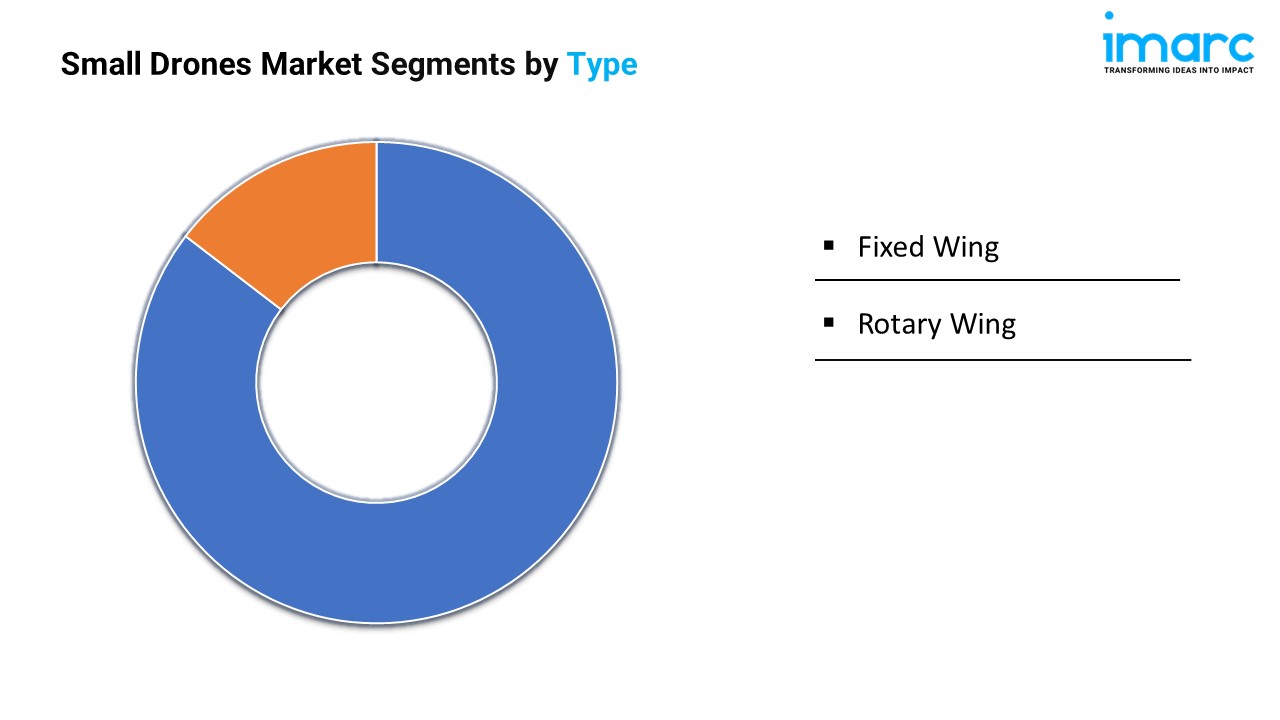
- Fixed Wing
- Rotary Wing
Rotary wing accounts for the majority of the market share because it offers superior maneuverability, stability, and versatility for a variety of tasks.
Breakup By Application:
- Military and Defense
- Consumer
- Consumer and Civil
Military and defense exhibit a clear dominance in the market, which can be attributed to the high demand for advanced, tactical small drones used for reconnaissance, surveillance, and tactical operations.
Breakup By Region:
- North America (United States, Canada)
- Asia Pacific (China, Japan, India, South Korea, Australia, Indonesia, Others)
- Europe (Germany, France, United Kingdom, Italy, Spain, Russia, Others)
- Latin America (Brazil, Mexico, Others)
- Middle East and Africa
North America enjoys the leading position in the small drones market owing to its early adoption of drone technology, substantial investments in research and development (RD) activities, and increasing demand from commercial and public sectors.
Top Small Drones Market Leaders:
The small drones market research report outlines a detailed analysis of the competitive landscape, offering in-depth profiles of major companies. Some of the key players in the market are:
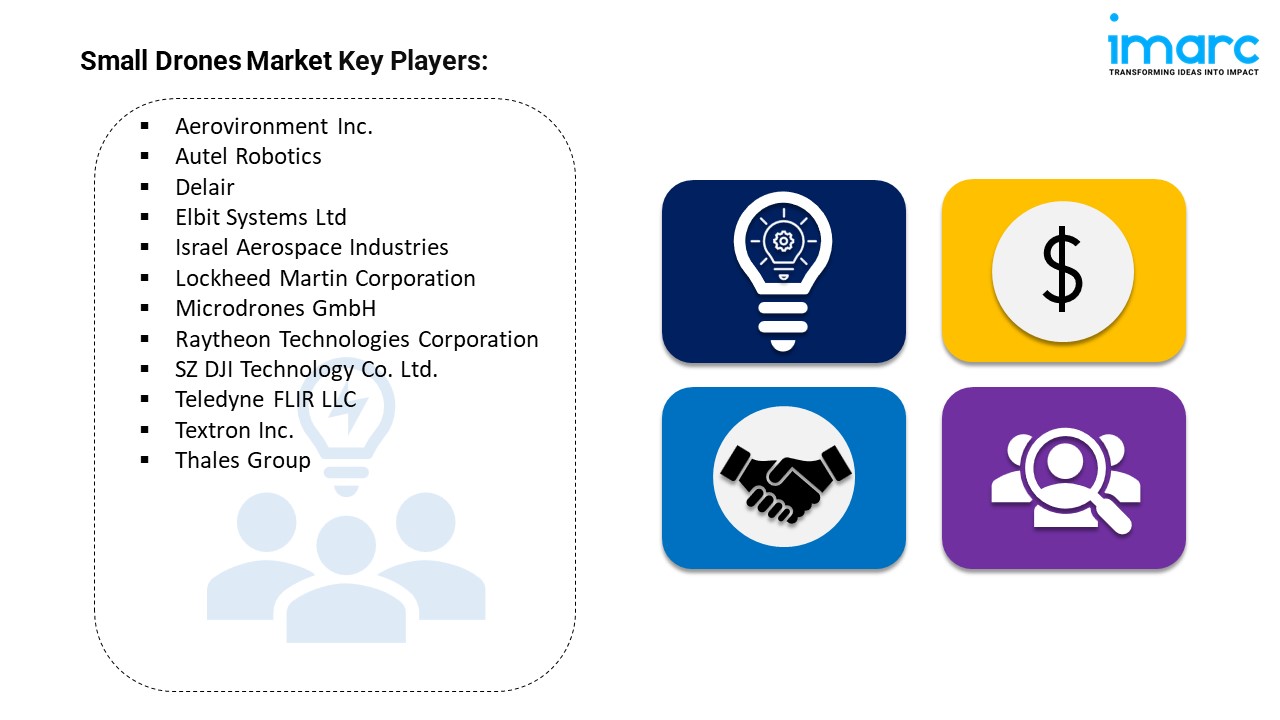
- Aerovironment Inc.
- Autel Robotics
- Delair
- Elbit Systems Ltd
- Israel Aerospace Industries
- Lockheed Martin Corporation
- Microdrones GmbH
- Raytheon Technologies Corporation
- SZ DJI Technology Co. Ltd.
- Teledyne FLIR LLC
- Textron Inc.
- Thales Group
If you require any specific information that is not currently covered within the scope of the report, we will provide the same as part of the customization.
About Us:
IMARC Group is a global management consulting firm that helps the world’s most ambitious changemakers to create a lasting impact. The company provides a comprehensive suite of market entry and expansion services. IMARC offerings include thorough market assessment, feasibility studies, company incorporation assistance, factory setup support, regulatory approvals and licensing navigation, branding, marketing and sales strategies, competitive landscape and benchmarking analyses, pricing and cost research, and procurement research.
Contact Us:
IMARC Group
134 N 4th St. Brooklyn, NY 11249, USA
Email: [email protected]
Tel No: (D) +91 120 433 0800
United States: +1-631-791-1145
Global Industrial Gloves Market Statistics: USD 19.1 Billion Value by 2032
Summary:
- The global industrial gloves market size reached USD 10.2 Billion in 2023.
- The market is expected to reach USD 19.1 Billion by 2032, exhibiting a growth rate (CAGR) of 7.1% during 2024-2032.
- North America leads the market, accounting for the largest industrial gloves market share.
- Disposable gloves accounts for the majority of the market share in the product segment due to their growing adoption in other sectors as people are getting aware about health and safety practices.
- Natural rubber gloves hold the largest share in the industrial gloves industry.
- Based on the sales channel, the market has been bifurcated into direct sales and distribution sales.
- On the basis of the end use, the market has been classified into pharmaceuticals, automotive and transportation, food, oil and gas, mining, chemicals, and others.
- The rising workplace safety regulations is a primary driver of the industrial gloves market.
- The growing awareness about hand protection is reshaping the industrial gloves market.
Industry Trends and Drivers:
- Growing workplace safety regulations:
In many industries, governments and regulatory bodies, such as Occupational Safety and Health Administration (OSHA) in the U.S., European Agency for Safety and Health at Work (EU-OSHA), and similar agencies in other countries enforce strict workplace safety guidelines. These regulations require companies to ensure their workers are provided with personal protective equipment (PPE), including gloves, in hazardous environments. Failure to comply can result in heavy fines, legal liabilities, and reputational damage, making glove usage a necessity. Industries, such as construction, manufacturing, chemicals, healthcare, and mining present workers with risks like cuts, burns, chemical exposure, and infection. Safety standards mandate that employees in these environments must wear appropriate hand protection to mitigate risks.
- Rising awareness about hand protection:
Awareness about the risks associated with hand injuries and diseases has grown, leading to a stronger focus on occupational health and safety. Organizations are now more proactive in adopting measures to protect their employees. This heightened awareness encourages companies to invest in high-quality industrial gloves to prevent injuries and improve workplace safety. Many industries and organizations conduct educational campaigns and training programs to highlight the importance of hand protection. These initiatives emphasize the potential dangers of not using proper gloves and the benefits of wearing them. As a result, workers and employers are more inclined to use protective gloves, boosting market demand.
- Technological advancements and smart home integration:
New materials, such as nitrile, neoprene, and polyurethane are being used to create gloves with improved durability, flexibility, and resistance to chemicals, abrasions, and extreme temperatures. This expands the range of applications for industrial gloves. The incorporation of nanotechnology into glove materials enhances their strength, resistance, and protective qualities. Nanoparticles can provide additional features such as antimicrobial properties or improved grip. Advances in materials and weaving techniques have led to the development of cut-resistant and impact-resistant gloves that offer higher levels of protection against sharp objects and heavy impacts, addressing specific safety needs in industries like construction and manufacturing.
Request for a sample copy of this report: https://www.imarcgroup.com/industrial-gloves-market/requestsample
Industrial Gloves Market Report Segmentation:
Breakup By Product:
- Reusable Gloves
- Disposable Gloves
Reusable gloves represent the largest segment due to their cost-effectiveness and suitability for multiple applications across various industries, reducing the need for frequent replacements.
Breakup By Material Type:
- Natural Rubber Gloves
- Nitrile Gloves
- Vinyl Gloves
- Neoprene Gloves
- Polyethylene Gloves
- Others
Natural rubber gloves account for the majority of the market share. Natural rubber gloves are preferred for their superior elasticity, comfort, and durability, making them the most widely used material in the industrial gloves market.
Breakup By Sales Channel:

- Direct Sales
- Distribution Sales
Based on the sales channel, the market has been bifurcated into direct sales and distribution sales.
Breakup By End Use:
- Pharmaceuticals
- Automotive and Transportation
- Food
- Oil and Gas
- Mining
- Chemicals
- Others
On the basis of the end use, the market has been classified into pharmaceuticals, automotive and transportation, food, oil and gas, mining, chemicals, and others.
Breakup By Region:
- North America (United States, Canada)
- Asia Pacific (China, Japan, India, South Korea, Australia, Indonesia, Others)
- Europe (Germany, France, United Kingdom, Italy, Spain, Russia, Others)
- Latin America (Brazil, Mexico, Others)
- Middle East and Africa
North America enjoys the leading position in the industrial gloves market owing to stringent safety regulations, high industrial activity, and significant investments in protective equipment.
Top Industrial Gloves Market Leaders:
The industrial gloves market research report outlines a detailed analysis of the competitive landscape, offering in-depth profiles of major companies. Some of the key players in the market are:
- 3M Company
- Ansell Limited
- Cintas Corporation
- Dipped Products PLC
- Hartalega Holdings Berhad
- Honeywell International Inc.
- Lakeland Industries Inc.
- Magid Glove & Safety Manufacturing Co LLC
- Riverstone Holdings Limited
- Shun Thai Rubber Gloves Industry Public Company Limited
- Smart Glove Corporation Sdn Bhd
- Top Glove Corporation Bhd
- Uvex Winter Holding Gmbh & Co. Kg.
If you require any specific information that is not covered currently within the scope of the report, we will provide the same as a part of the customization.
About Us:
IMARC Group is a global management consulting firm that helps the world’s most ambitious changemakers to create a lasting impact. The company provide a comprehensive suite of market entry and expansion services. IMARC offerings include thorough market assessment, feasibility studies, company incorporation assistance, factory setup support, regulatory approvals and licensing navigation, branding, marketing and sales strategies, competitive landscape and benchmarking analyses, pricing and cost research, and procurement research.
Contact Us:
IMARC Group
134 N 4th St. Brooklyn, NY 11249, USA
Email: [email protected]
Tel No:(D) +91 120 433 0800
United States: +1-631-791-1145
Global Solar Photovoltaic (PV) Industry: Key Statistics and Insights in 2024-2032
Summary:
- The global solar photovoltaic (PV) market size reached USD 1,204.1 TWh in 2023.
- The market is expected to reach USD 4,432.1 TWh by 2032, exhibiting a growth rate (CAGR) of 15.1% during 2024-2032.
- Asia Pacific leads the market, accounting for the largest solar photovoltaic (PV) market share.
- On-grid represents the largest segment due to its ability to provide a consistent energy supply by connecting to the utility grid, facilitating the sale of excess electricity generated.
- Utility represents the largest segment as large-scale solar installations are increasingly adopted by utilities to meet renewable energy targets and supply electricity on a mass scale.
- Supportive government policies and incentives play a crucial role in driving the market growth of the solar photovoltaic (PV) industry.
- Continuous technological advancements in solar PV panels, including increases in efficiency and reductions in manufacturing costs, are key factors propelling the market growth.
Industry Trends and Drivers:
- Increasing Government Policies and Incentives:
Supportive government policies and incentives play a crucial role in driving the market growth of the solar photovoltaic (PV) industry. Various countries are introducing subsidies, tax incentives, and feed-in tariffs to encourage the adoption of solar energy. This regulatory support is instrumental in reducing the cost of solar installations, making solar energy more accessible and appealing to both residential and commercial sectors. Market analysis suggests that such policies act as a significant growth driver, contributing to the positive market outlook for solar PV technology.
- Continuous Technological Advancements:
Continuous technological advancements in solar PV panels, including increases in efficiency and reductions in manufacturing costs, are key factors propelling the market growth. In addition to this, innovations such as bifacial panels and PERC (Passivated Emitter and Rear Cell) technology enhance the power output and efficiency of solar installations. These technological improvements enhance the market size by making solar energy more cost-effective compared to traditional energy sources and also expand the market share of solar PV in the renewable energy sector.
- Rising Awareness of Renewable Energy:
The growing global awareness and commitment to renewable energy sources to combat climate change are significantly influencing market trends in the Solar Photovoltaic (PV) sector. There is an increasing demand for clean and sustainable energy solutions, which positions solar energy as a key player in the transition towards a greener economy. This shift in consumer and corporate behavior towards renewable energy sources is expected to drive the market growth, as reflected in market analysis and outlook reports that forecast a robust expansion of the solar PV market.
Request for a sample copy of this report: https://www.imarcgroup.com/solar-photovoltaic-market/requestsample
Solar Photovoltaic (PV) Market Report Segmentation:
By Type:

- Thin Film
- Multi-Si
- Mono-Si
On the basis of type, the market has been divided into thin film, multi-Si, and mono-Si.
By Grid Type:
- On-Grid
- Off-Grid
On-grid represents the largest segment due to its ability to provide a consistent energy supply by connecting to the utility grid, facilitating the sale of excess electricity generated.
By Deployment:
- Ground-mounted
- Rooftop Solar
Ground-mounted represents the largest segment due to its scalability and efficiency advantages, allowing for optimal solar panel orientation and exposure to sunlight.
By End User:
- Residential
- Commercial
- Utility
Utility represents the largest segment as large-scale solar installations are increasingly adopted by utilities to meet renewable energy targets and supply electricity on a mass scale.
Regional Insights:
- North America (United States, Canada)
- Asia Pacific (China, Japan, India, South Korea, Australia, Indonesia, Others)
- Europe (Germany, France, United Kingdom, Italy, Spain, Russia, Others)
- Latin America (Brazil, Mexico, Others)
- Middle East and Africa
Asia Pacific’s dominance in the solar photovoltaic (PV) market is attributed to the rising implementation of stringent regulations encouraging individuals and businesses to invest in renewable energy sources.
Top Solar Photovoltaic (PV) Market Leaders:
The solar photovoltaic (PV) market research report outlines a detailed analysis of the competitive landscape, offering in-depth profiles of major companies. Some of the key players in the market are:
- Acciona S.A.
- Canadian Solar Inc.
- First Solar Inc.
- JA Solar Technology Co
- JinkoSolar Holding Co. Ltd.
- LONGi Green Energy Technology Co. Ltd.
- Sharp Corporation
- Solar Frontier K.K
- SunPower Corporation
- Suntech Power Co. Ltd. (Shunfeng Int'l)
- Tata Power Solar Systems Limited (Tata Power Company Limited)
- Trina Solar Co. Ltd.
If you require any specific information that is not covered currently within the scope of the report, we will provide the same as a part of the customization.
About Us
IMARC Group is a global management consulting firm that helps the world’s most ambitious changemakers to create a lasting impact. The company provide a comprehensive suite of market entry and expansion services. IMARC offerings include thorough market assessment, feasibility studies, company incorporation assistance, factory setup support, regulatory approvals and licensing navigation, branding, marketing and sales strategies, competitive landscape and benchmarking analyses, pricing and cost research, and procurement research.
Contact US
IMARC Group
134 N 4th St. Brooklyn, NY 11249, USA
Email: [email protected]
Tel No:(D) +91 120 433 0800
United States: +1–631–791–1145
Global Drinkable Yogurt Market Statistics: USD 60.8 Billion Value by 2032
Summary:
The global drinkable yogurt market size reached USD 38.3 Billion in 2023.
The market is expected to reach USD 60.8 Billion by 2032, exhibiting a growth rate (CAGR) of 5.26% during 2024-2032.
Asia Pacific leads the market, accounting for the largest drinkable yogurt market share.
Flavored yogurt accounts for the majority of the market share in the type segment due to its ability to cater to diverse consumer preferences.
Non-dairy based yogurt holds the largest share in the drinkable yogurt industry.
Supermarkets and hypermarkets remain a dominant segment in the market owing to their strategic locations, promotional offers, and the opportunity to shop for multiple products in one place.
The rising focus on health and wellness is a primary driver of the drinkable yogurt market.
The introduction of new flavors and the growing interest in plant-based alternatives are reshaping the drinkable yogurt market.
Industry Trends and Drivers:
Increasing health awareness:
The rising awareness among the masses about health and wellness is driving the demand for nutritious food options like drinkable yogurt, which represents one of the key factors propelling the growth of the market. As people are becoming more aware about numerous benefits associated with gut health, they are seeking products that contain probiotics, vitamins, and essential minerals. This growing trend is encouraging individuals to incorporate drinkable yogurt into their diets as a convenient source of nutrition. In response, brands are formulating yogurt products enriched with added nutrients and functional ingredients to cater to this health-conscious demographic. Marketing campaigns are also effectively highlighting the health benefits of drinkable yogurt, which is resonating with consumers eager to enhance their overall well-being.
Rising demand for plant-based options:
The growing trend of plant-based diets is catalyzing the demand for drinkable yogurt made from alternative sources, as consumers are seeking dairy-free options for various reasons, including lactose intolerance and ethical considerations. As awareness about the environmental impact of traditional dairy farming is increasing, individuals are opting for plant-based products that align with their dietary preferences. This shift is prompting brands to innovate with yogurt alternatives derived from ingredients like almonds, coconuts, soy, and oats, which are appealing to a broader range of consumers. The ongoing transition towards plant-based options is reshaping consumer expectations and expanding the drinkable yogurt category, thereby supporting the market growth.
Flavor innovations and product variety:
Manufacturers are experimenting with innovative flavors and unique combinations to captivate consumers and enhance their product offerings. With the rising demand for distinctive taste experiences, brands are introducing new options, which is positively influencing the market. Consumers are looking for products that meet their nutritional needs and provide enjoyable and memorable taste experiences. As a result, companies are developing limited-edition flavors and seasonal offerings, creating a sense of urgency among consumers. In addition, many brands are prioritizing natural ingredients and reducing the use of artificial flavoring to align with the increasing preference for clean-label products, thereby contributing to the market growth.
Request for a sample copy of this report: https://www.imarcgroup.com/drinkable-yogurt-market/requestsample
Drinkable Yogurt Market Report Segmentation:
Breakup By Type:
Plain Yogurt
Flavored Yogurt
Flavored yogurt represents the largest segment because consumers are seeking diverse and enjoyable taste experiences.
Breakup By Category:
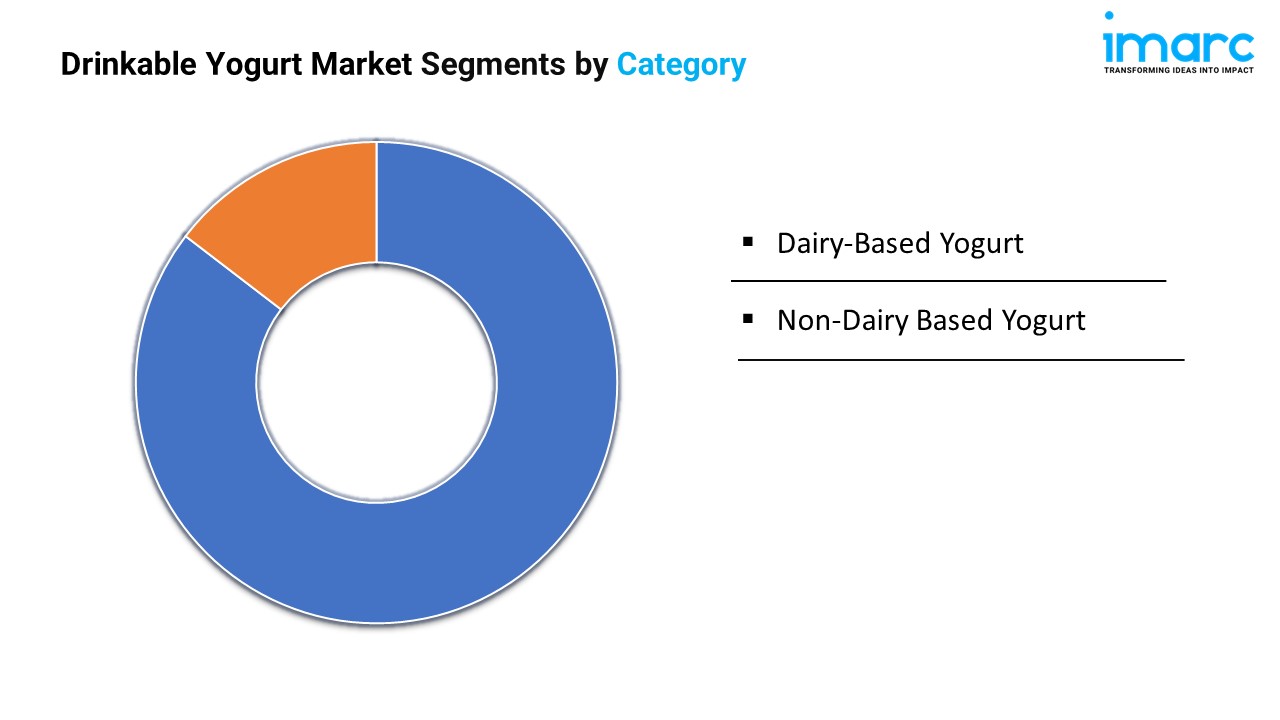
Dairy-Based Yogurt
Non-Dairy Based Yogurt
Non-dairy based yogurt accounts for the majority of the market share as the rising demand for plant-based diets is driving consumers towards dairy-free alternatives.
Breakup By Distribution Channel:
Supermarkets and Hypermarkets
Convenience Stores
Specialty Stores
Online Stores
Others
Supermarkets and hypermarkets exhibit a clear dominance in the market due to their extensive product range, convenience, and the ability to attract a large volume of shoppers looking for a variety of drinkable yogurt options.
Breakup By Region:
North America (United States, Canada)
Asia Pacific (China, Japan, India, South Korea, Australia, Indonesia, Others)
Europe (Germany, France, United Kingdom, Italy, Spain, Russia, Others)
Latin America (Brazil, Mexico, Others)
Middle East and Africa
Asia Pacific enjoys the leading position in the drinkable yogurt market, which can be attributed to the increasing health consciousness among consumers and the growing preference for yogurt as a nutritious beverage.
Top Drinkable Yogurt Market Leaders:
The drinkable yogurt market research report outlines a detailed analysis of the competitive landscape, offering in-depth profiles of major companies. Some of the key players in the market are:
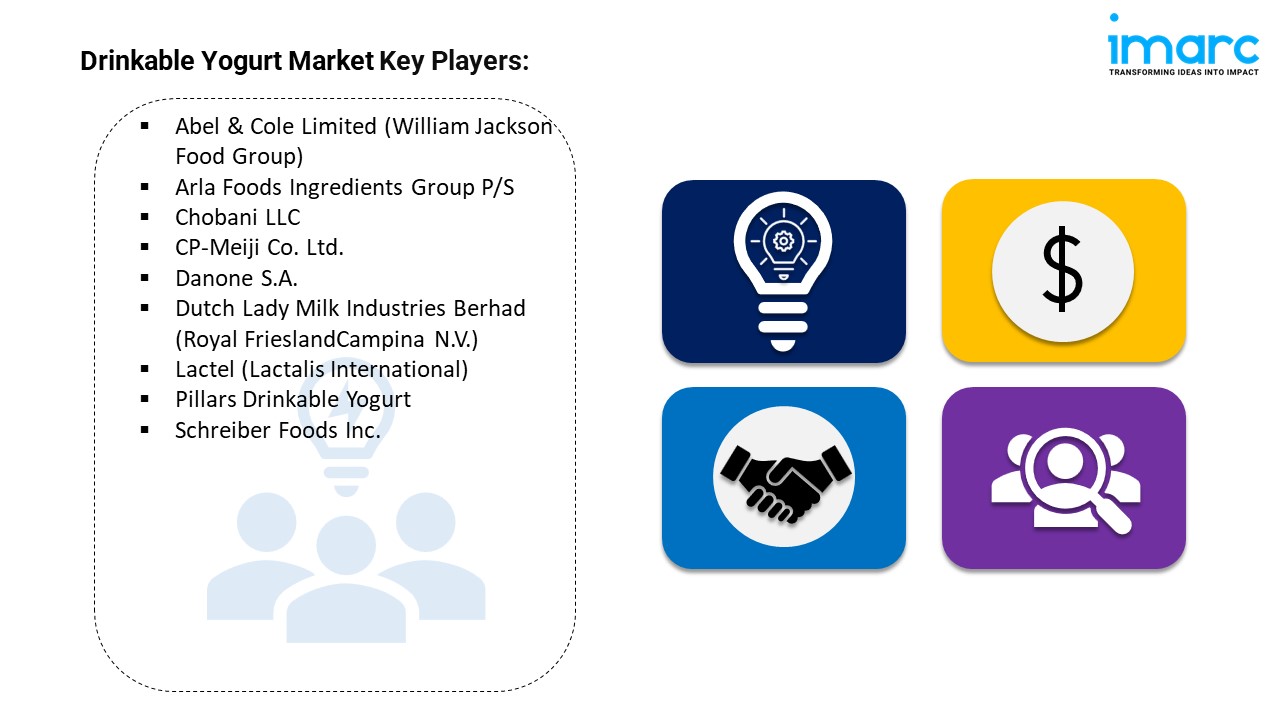
Abel & Cole Limited (William Jackson Food Group)
Arla Foods Ingredients Group P/S
Chobani LLC
CP-Meiji Co. Ltd.
Danone S.A.
Dutch Lady Milk Industries Berhad (Royal FrieslandCampina N.V.)
Lactel (Lactalis International)
Pillars Drinkable Yogurt
Schreiber Foods Inc.
If you require any specific information that is not covered currently within the scope of the report, we will provide the same as a part of the customization.
About Us:
IMARC Group is a global management consulting firm that helps the world’s most ambitious changemakers to create a lasting impact. The company provide a comprehensive suite of market entry and expansion services. IMARC offerings include thorough market assessment, feasibility studies, company incorporation assistance, factory setup support, regulatory approvals and licensing navigation, branding, marketing and sales strategies, competitive landscape and benchmarking analyses, pricing and cost research, and procurement research.
Contact Us:
IMARC Group
134 N 4th St. Brooklyn, NY 11249, USA
Email: [email protected]
Tel No:(D) +91 120 433 0800
United States: +1-631-791-1145
Global Single-use Medical Device Reprocessing Market Statistics: USD 2382.0 Million Value by 2032
Summary:
- The global single-use medical device reprocessing market size reached USD 805.2 Million in 2023.
- The market is expected to reach USD 2382.0 Million by 2032, exhibiting a growth rate (CAGR) of 12.6% during 2024-2032.
- North America leads the market, accounting for the largest single-use medical device reprocessing market share.
- Based on the application, the market has been divided into general surgery, anesthesia, arthroscopy and orthopaedic surgery, cardiology, gastroenterology, gynaecology, urology, and others.
- Hospitals account for the majority of the market share owing to the increasing number of patients seeking effective healthcare services.
- The rising need for cost reduction in healthcare services is impelling the growth of the market.
- Environmental sustainability is becoming a priority in various sectors, including healthcare, driving the need for single-use medical devices.
Industry Trends and Drivers:
- Cost Efficiency and Budget Constraints in Healthcare Systems:
The rising need for cost reduction in healthcare services is impelling the growth of the market. Reprocessing of single-use medical devices (SUDs) involves the cleaning, disinfecting, and sterilizing of devices originally intended for one-time use to ensure they are safe for reuse. This process can lead to substantial cost savings for healthcare facilities, which is particularly crucial as these institutions face constant pressure to manage budgets effectively. Moreover, reprocessed devices can cost less than their new counterparts, allowing hospitals and clinics to allocate resources more efficiently elsewhere, such as toward patient care or the adoption of advanced technologies.
- Environmental Concerns and Sustainability Practices:
Environmental sustainability is becoming a priority in various sectors, including healthcare, driving the need for single-use medical devices. Reprocessing helps reduce medical waste significantly, which is critical given the large volume of waste generated by healthcare facilities annually. By reusing devices, hospitals can minimize their environmental footprint, decreasing the amount of non-biodegradable waste deposited in landfills and reducing the need for new raw materials to manufacture more devices. Furthermore, this practice aligns with global initiatives aimed at promoting sustainability in healthcare by not only managing waste but also conserving energy and water used in the production and disposal of medical devices.
- Regulatory Support and Advancements in Reprocessing Technologies:
The expansion of the market is also supported by favorable regulatory frameworks established by healthcare authorities worldwide. Regulatory bodies have set stringent guidelines and standards for the reprocessing of SUDs to ensure they meet safety and performance criteria akin to new devices. These regulations are bolstering the confidence of healthcare providers in using reprocessed devices. Additionally, advancements in reprocessing technology are improving the efficiency and safety of reprocessed devices, making them more appealing to healthcare facilities.
Request for a sample copy of this report: https://www.imarcgroup.com/single-use-medical-device-reprocessing-market/requestsample
Single-use Medical Device Reprocessing Market Report Segmentation:
By Device Type:
- Class I Devices
- Laparoscopic Graspers
- Scalpels
- Tourniquet Cuffs
- Other Class I Devices
- Class II Devices
- Pulse Oximeter Sensors
- Sequential Compression Sleeves
- Catheters and Guidewires
- Other Class II Devices
Class II devices represent the largest segment as they allow healthcare facilities to significantly reduce procurement costs.
By Application:
- General Surgery
- Anesthesia
- Arthroscopy and Orthopaedic Surgery
- Cardiology
- Gastroenterology
- Gynaecology
- Urology
- Others
Based on the application, the market has been divided into general surgery, anesthesia, arthroscopy and orthopaedic surgery, cardiology, gastroenterology, gynaecology, urology, and others.
By End User:

- Hospitals
- Ambulatory Surgical Centers
- Others
Hospitals account for the majority of the market share owing to the increasing number of patients seeking effective healthcare services.
Regional Insights:
- North America (United States, Canada)
- Asia Pacific (China, Japan, India, South Korea, Australia, Indonesia, Others)
- Europe (Germany, France, United Kingdom, Italy, Spain, Russia, Others)
- Latin America (Brazil, Mexico, Others)
- Middle East and Africa
North America’s dominance in the single-use medical device reprocessing market is attributed to the rising focus on environmental sustainability and waste reduction.
Top Single-use Medical Device Reprocessing Market Leaders:
The single-use medical device reprocessing market research report outlines a detailed analysis of the competitive landscape, offering in-depth profiles of major companies. Some of the key players in the market are:
- Arjo Inc.
- Innovative Health
- Johnson & Johnson
- Medline Industries LP
- NEScientific Inc.
- Steripro Canada
- Stryker Corporation
- SureTek Medical
- Vanguard AG
If you require any specific information that is not covered currently within the scope of the report, we will provide the same as a part of the customization.
About Us:
IMARC Group is a global management consulting firm that helps the world’s most ambitious changemakers to create a lasting impact. The company provide a comprehensive suite of market entry and expansion services. IMARC offerings include thorough market assessment, feasibility studies, company incorporation assistance, factory setup support, regulatory approvals and licensing navigation, branding, marketing and sales strategies, competitive landscape and benchmarking analyses, pricing and cost research, and procurement research.
Contact Us:
IMARC Group
134 N 4th St. Brooklyn, NY 11249, USA
Email: [email protected]
Tel No:(D) +91 120 433 0800
United States: +1-631-791-1145
Global Automotive Alternator Industry: Key Statistics and Insights in 2024-2032
Summary:
- The global automotive alternator market size reached USD 25.7 Billion in 2023.
- The market is expected to reach USD 41.1 Billion by 2032, exhibiting a growth rate (CAGR) of 5.26% during 2024–2032.
- Asia-Pacific leads the market, accounting for the largest automotive alternator market share.
- IC engine vehicles account for the majority of the market share in the powertrain type segment owing to their reliance on alternators for electrical power generation.
- Passenger cars hold the largest share in the automotive alternator industry.
- The advancement in vehicle electrification is a primary driver of the automotive alternator market.
- The rising demand for fuel efficiency and stringent regulatory standards are reshaping the automotive alternator market.
Industry Trends and Drivers:
● Increasing vehicle electrification:
The automotive industry is experiencing a significant shift towards electrification, driven by advancements in electric vehicles (EVs) and hybrid technologies. This trend is creating a growing demand for high-efficiency alternators capable of supporting complex electrical systems in modern vehicles. As vehicles integrate more electronic components and require higher power outputs, alternators must evolve to meet these needs. Manufacturers are concentrating on creating advanced alternators that offer enhanced performance and energy efficiency to address this growing market. The rising of vehicle electrification is driving the demand for the automotive alternator, as automakers are seeking reliable solutions to power sophisticated vehicle systems.
● Advancements in technology and materials:
Technological innovations and the use of advanced materials are transforming the automotive alternator market. Enhancements, such as improved rotor and stator designs, the adoption of lightweight materials, and advanced cooling systems are significantly increasing alternator efficiency, performance, and reliability. High-strength magnets and advanced thermal management techniques are enabling the development of more compact and effective alternators. Manufacturers are actively investing in research and development (R&D) activities to introduce cutting-edge technologies that meet the requirements of modern vehicles. These advancements are supporting the market growth by offering more durable and efficient solutions that align with the higher power demands and improved energy management.
● Rising demand for fuel efficiency:
Increasing user awareness and stringent regulatory standards are driving the demand for higher fuel efficiency in vehicles, leading automakers to seek technologies that reduce energy consumption. Modern alternators enhance the efficiency of the electrical system of a vehicle and reduce the load on the engine. Features, such as variable voltage control and regenerative charging, are becoming more prominent, as they optimize power generation and cut down on fuel consumption. This trend is encouraging innovations in alternator design, resulting in advanced, energy-efficient solutions aiming to improve fuel economy and minimize emissions. Manufacturers are focusing on developing alternators that contribute to enhanced performance and environment sustainability.
Request for a sample copy of this report: https://www.imarcgroup.com/automotive-alternator-market/requestsample
Automotive Alternator Market Report Segmentation:
Breakup By Powertrain Type:

- IC Engine Vehicles
- Hybrid and Electric Vehicles
IC engine vehicles represent the largest segment because they have the highest volume of production and use.
Breakup By Vehicle Type:
- Passenger Cars
- Commercial Vehicles
Passenger cars exhibit a clear dominance in the market due to their high production rates and widespread use.
Breakup By Region:
- North America (United States, Canada)
- Asia Pacific (China, Japan, India, South Korea, Australia, Indonesia, Others)
- Europe (Germany, France, United Kingdom, Italy, Spain, Russia, Others)
- Latin America (Brazil, Mexico, Others)
- Middle East and Africa
Asia-Pacific enjoys the leading position in the automotive alternator market, which can be attributed to its large automotive manufacturing base, high vehicle production volumes, and increasing automotive industry in developing countries.
Top Automotive Alternator Market Leaders:
The automotive alternator market research report outlines a detailed analysis of the competitive landscape, offering in-depth profiles of major companies. Some of the key players in the market are:
- BorgWarner Inc.
- DENSO Corporation
- Hella KGaA Hueck & Co. (Faurecia SE)
- Hitachi Ltd.
- Hyundai Mobis (Hyundai Motor Group)
- Jinzhou Halla Electrical Equipment Co. Ltd
- MAHLE GmbH (Mahle Stiftung GmbH)
- Mecc Alte SpA (Co.mecc.fin.srl)
- Mitsubishi Electric Corporation
- Motorcar Parts of America Inc.
- Prestolite Electric Incorporated (Prestolite Electric Holding Inc.)
- Robert Bosch GmbH (Robert Bosch Stiftung GmbH)
- Valeo.
Note: If you require any specific information that is not covered currently within the scope of the report, we will provide the same as a part of the customization.
About Us:
IMARC Group is a global management consulting firm that helps the world’s most ambitious changemakers to create a lasting impact. The company provide a comprehensive suite of market entry and expansion services. IMARC offerings include thorough market assessment, feasibility studies, company incorporation assistance, factory setup support, regulatory approvals and licensing navigation, branding, marketing and sales strategies, competitive landscape and benchmarking analyses, pricing and cost research, and procurement research.
Contact Us:
IMARC Group
134 N 4th St. Brooklyn, NY 11249, USA
Email: [email protected]
Tel No:(D) +91 120 433 0800
United States: +1–631–791–1145
Global Enteric Disease Testing Market Statistics: USD 5.5 Billion Value by 2032
Summary:
- The global enteric disease testing market size reached USD 4.2 Billion in 2023.
- The market is expected to reach USD 5.5 Billion by 2032, exhibiting a growth rate (CAGR) of 3.1% during 2024–2032.
- Asia Pacific leads the market, accounting for the largest enteric disease testing market share.
- Based on the product type, the market has been bifurcated into reagents and consumables and equipment.
- Molecular diagnostics hold the largest share in the enteric disease testing industry.
- Bacterial enteric disease (C. difficile, Campylobacteriosis, Cholera, E. coli, H. pylori, Salmonellosis, and Shigellosis) represents the leading disease type segment.
- On the basis of the end user, the market has been classified into hospital diagnostic laboratories, independent diagnostic laboratories, academic and research institutes, and others.
- The growing focus on preventive healthcare is a primary driver of the enteric disease testing market.
- The rise of point-of-care (POC) testing solutions and the increasing public awareness and education are reshaping the enteric disease testing market.
Industry Trends and Drivers:
● Growing focus on preventive healthcare:
Governing bodies and healthcare organizations are emphasizing early detection and intervention strategies to mitigate the spread of infectious diseases. Regular screening and diagnostic testing for enteric diseases, especially in at-risk populations, are being promoted as essential public health measures. This shift from reactive to preventive approaches aims to reduce the burden on healthcare systems by catching infections before they develop into larger outbreaks. In countries with advanced healthcare infrastructure, preventive testing is becoming a routine part of public health programs, particularly for food safety, water quality monitoring, and sanitation practices. The rising awareness about the importance of early diagnosis in controlling the spread of enteric diseases is catalyzing the demand for testing services.
● Rise of point-of-care (POC) testing solutions:
The increasing demand for point-of-care (POC) testing solutions represents one of the key factors impelling the market growth. These portable, user-friendly diagnostic tools allow for rapid testing near patients or in remote settings, reducing the time required for results and facilitating faster treatment decisions. POC diagnostics are particularly important in low-resource environments where access to central laboratories may be limited. The ease of use, coupled with the reduced need for specialized training to operate these devices, makes POC testing an attractive option in both developed and developing regions. The growing cases of enteric diseases are driving the need for fast, on-the-spot testing solutions. In addition to healthcare facilities, these tests are being deployed in areas like food production and water quality monitoring, ensuring broader market applications.
● Increasing public awareness and education:
Growing public awareness about the risks of enteric diseases and the importance of hygiene is driving the need for more comprehensive and accessible testing solutions. Governments and health organizations are increasing their efforts to educate the public on how enteric diseases spread, their symptoms, and the importance of timely testing and treatment. Mass media campaigns, educational programs in schools, and community outreach initiatives are raising awareness about the importance of clean water, proper sanitation, and food safety, especially in regions prone to frequent outbreaks. The rising demand for reliable diagnostic testing is a direct result of these educational efforts, as individuals become more proactive in seeking testing when symptoms of enteric diseases arise.
Request for a sample copy of this report: https://www.imarcgroup.com/enteric-disease-testing-market/requestsample
Enteric Disease Testing Market Report Segmentation:
Breakup By Product Type:
- Reagents and Consumables
- Equipment
Based on the product type, the market has been bifurcated into reagents and consumables and equipment.
Breakup By Technology:

- Molecular Diagnostics
- Immunodiagnostics
Molecular diagnostics exhibit a clear dominance in the market attributed to its high accuracy and speed in detecting enteric pathogens.
Breakup By Disease Type:
- Bacterial Enteric Disease
- C. Difficile
- Campylobacteriosis
- Cholera
- E. Coli
- H. Pylori
- Salmonellosis
- Shigellosis
- Viral Enteric Disease
- Rotavirus
- Norovirus
- Others
- Parasitic Enteric Disease
- Amebiasis
- Cryptosporidiosis
- Giardiasis
Bacterial enteric disease (C. difficile, Campylobacteriosis, Cholera, E. coli, H. pylori, Salmonellosis, and Shigellosis) represents the largest segment, as bacterial infections are the most common cause of enteric diseases worldwide.
Breakup By End User:
- Hospital Diagnostic Laboratories
- Independent Diagnostic Laboratories
- Academic and Research Institutes
- Others
On the basis of the end user, the market has been classified into hospital diagnostic laboratories, independent diagnostic laboratories, academic and research institutes, and others.
Breakup By Region:
- North America (United States, Canada)
- Asia Pacific (China, Japan, India, South Korea, Australia, Indonesia, Others)
- Europe (Germany, France, United Kingdom, Italy, Spain, Russia, Others)
- Latin America (Brazil, Mexico, Others)
- Middle East and Africa
Asia Pacific dominates the market owing to a high prevalence of enteric diseases among the population and increasing investment in healthcare infrastructure.
Top Enteric Disease Testing Market Leaders:
The enteric disease testing market research report outlines a detailed analysis of the competitive landscape, offering in-depth profiles of major companies. Some of the key players in the market are:

- Abbott Laboratories
- BD (Becton, Dickinson and Company)
- Bio-Rad Laboratories Inc.
- Biomerica Inc.
- Biomérieux SA
- Cepheid Inc. (Danaher Corporation)
- Coris BioConcept
- DiaSorin
- Meridian Bioscience Inc.
- Quest Diagnostics
Note: If you require any specific information that is not covered currently within the scope of the report, we will provide the same as a part of the customization.
About Us
IMARC Group is a global management consulting firm that helps the world’s most ambitious changemakers to create a lasting impact. The company provide a comprehensive suite of market entry and expansion services. IMARC offerings include thorough market assessment, feasibility studies, company incorporation assistance, factory setup support, regulatory approvals and licensing navigation, branding, marketing and sales strategies, competitive landscape and benchmarking analyses, pricing and cost research, and procurement research.
Contact US
IMARC Group
134 N 4th St. Brooklyn, NY 11249, USA
Email: [email protected]
Tel No:(D) +91 120 433 0800
United States: +1–631–791–1145
